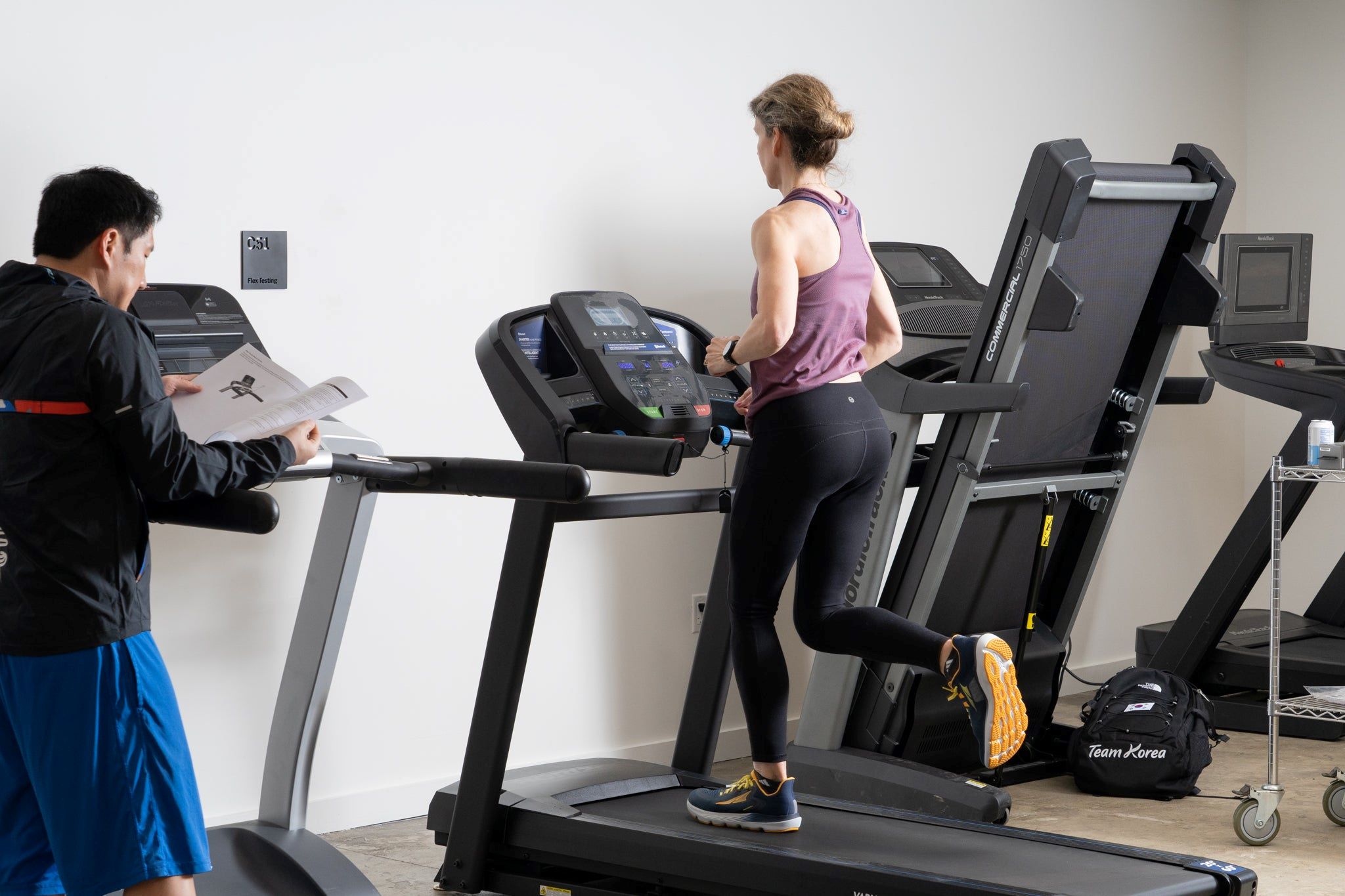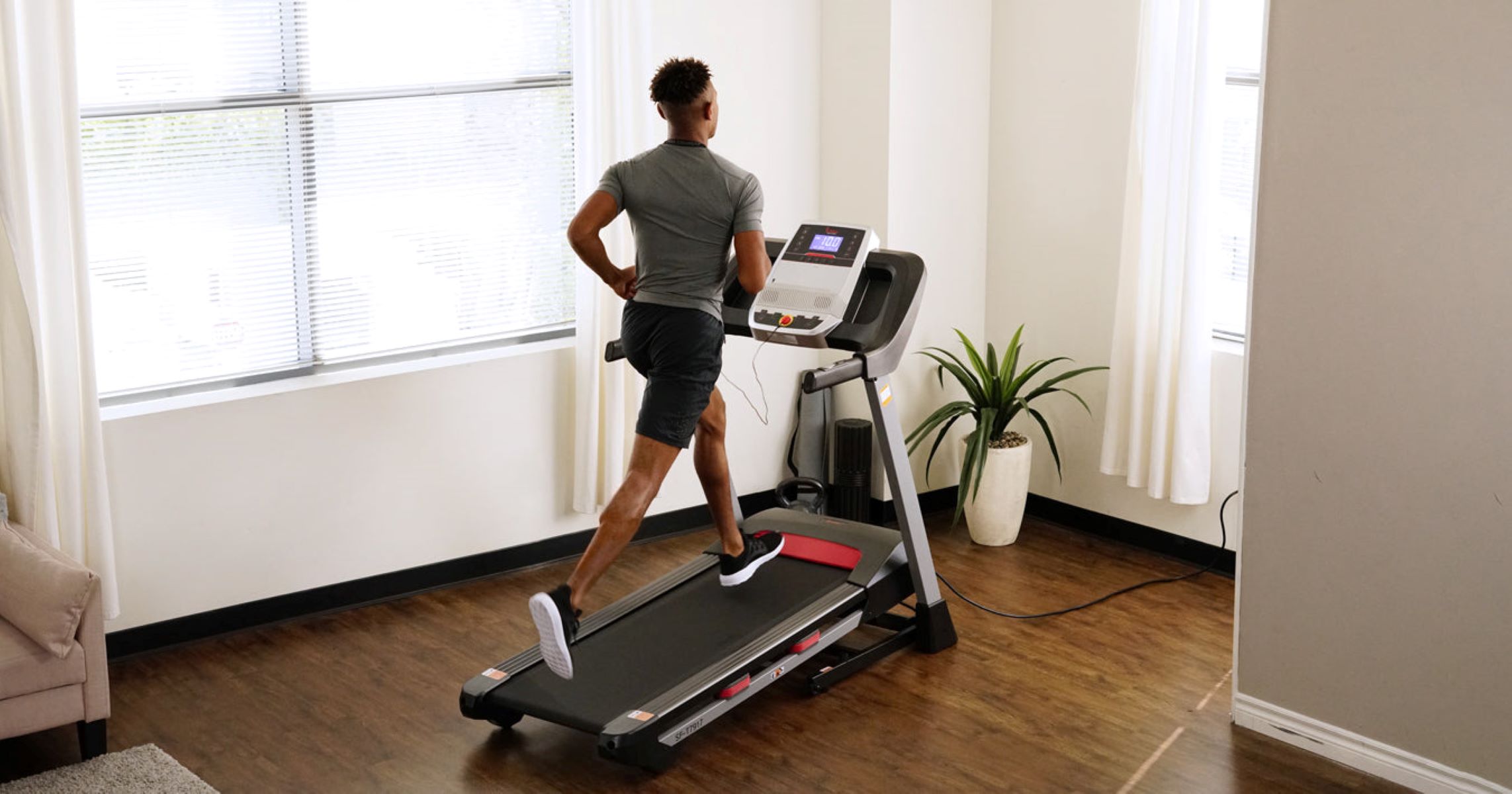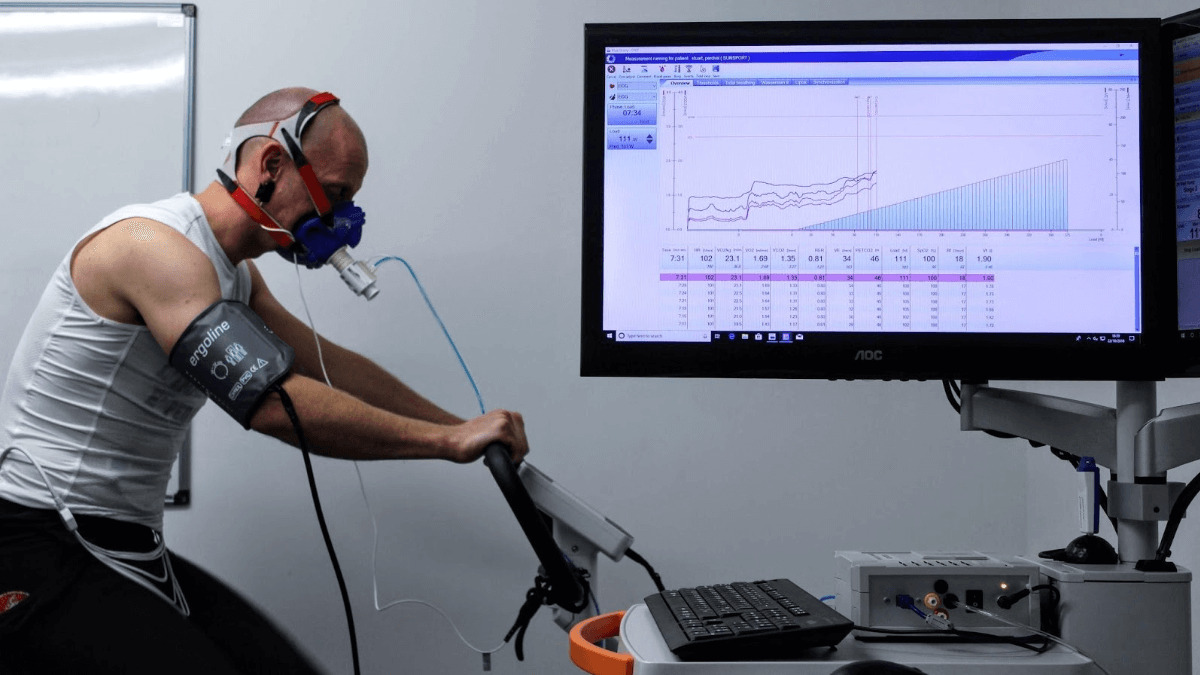Home>Misc>Featured>What Speed Is A 6 Minute Mile On A Treadmill


Featured
What Speed Is A 6 Minute Mile On A Treadmill
Modified: January 2, 2024
Learn how fast you can run a 6-minute mile on a treadmill. Discover the best tips and training techniques to achieve this high-intensity feat. Featured article
Introduction
Welcome to the world of treadmill running, where you have the freedom to control your pace and reach your fitness goals without stepping foot outside. As you embark on your treadmill journey, you may find yourself wondering what speed corresponds to a 6-minute mile. Whether you’re a seasoned runner or just starting out, understanding the relationship between treadmill speed settings and actual running pace is crucial for tracking your progress and setting realistic goals.
Running a 6-minute mile is no easy feat. It requires consistent training, endurance, and proper technique. But before we delve into the specifics, let’s first establish a clear understanding of treadmill speed settings and how they correlate to your running pace.
Treadmills typically have speed settings that range from a leisurely walking pace to an all-out sprint. These speed settings are usually displayed in miles per hour (mph) or kilometers per hour (km/h). It’s important to note that the speed displayed on the treadmill may not always be an accurate reflection of your actual running pace due to various factors, which we’ll discuss later in this article.
Now, let’s dive deeper into the concept of a 6-minute mile. Running a mile in 6 minutes means maintaining an average pace of 6 minutes per mile, or 10 miles per hour. Keep in mind that this is an advanced level of running and may not be achievable for everyone. However, it serves as a benchmark to strive for and a measure of your progress as you work towards improving your running speed.
Understanding treadmill speed settings
When you step onto a treadmill, you’ll notice that it offers a range of speed settings to choose from. These settings allow you to adjust the pace at which the treadmill belt moves, giving you control over your running speed. But how do these speed settings translate into actual running pace?
Treadmill speed settings are typically represented in miles per hour (mph) or kilometers per hour (km/h). When you select a specific speed setting, the treadmill adjusts the pace of the belt accordingly. For example, if you set the treadmill speed to 6 mph, the belt will move at a pace that corresponds to a 6-minute mile.
It’s important to note that treadmill speed settings are not always standardized across different treadmill models and brands. Therefore, the actual speed of the treadmill at a specific setting may vary. To ensure accuracy, it’s recommended to calibrate your treadmill periodically using a reliable method, such as using a GPS device or running on an outdoor track to compare your pace.
Furthermore, it’s worth mentioning that treadmill speed settings may also differ based on the unit of measurement used. In countries that use the metric system, such as kilometers per hour (km/h), the speed settings may be displayed in increments of 0.1 or 0.5 km/h. On the other hand, in countries that use the imperial system, such as the United States, the speed settings may be displayed in increments of 0.1 or 0.5 mph.
Understanding the relationship between treadmill speed settings and your running pace is crucial for accurately tracking your progress and setting realistic goals. By familiarizing yourself with the speed settings on your treadmill, you’ll be able to customize your workouts to meet your specific training needs. Whether you’re aiming for a leisurely walk, a brisk jog, or an all-out sprint, the speed settings on your treadmill provide the flexibility to tailor your workouts to your desired intensity level.
The concept of a 6-minute mile
The 6-minute mile is often seen as a significant milestone among runners. It represents an impressive level of speed and endurance, requiring a consistent pace of 6 minutes per mile for the entire distance. But what exactly does it mean to run a 6-minute mile?
A 6-minute mile is equivalent to running at a pace of 10 miles per hour (mph) or approximately 16.09 kilometers per hour (km/h). This means that for each minute of running, you cover one-sixth of a mile or approximately 0.27 kilometers. It’s important to note that sustaining this pace for an entire mile is a challenging feat that requires a high level of fitness and training.
For many runners, achieving a 6-minute mile is a personal goal and a benchmark of their running ability. It represents a level of speed and endurance that few can attain. It takes consistent training, proper technique, and a strong cardiovascular system to maintain this pace for the duration of a mile.
Running a 6-minute mile requires a combination of speed and stamina. It involves pushing your body to its limits and maintaining a fast yet sustainable pace. To achieve this, runners often incorporate interval training, tempo runs, and speed workouts into their training routines. These workouts help develop the necessary speed, endurance, and mental resilience required to sustain a 6-minute mile.
It’s important to remember that the ability to run a 6-minute mile can vary greatly among individuals, depending on factors such as age, fitness level, and genetic predisposition. What may be an attainable goal for one person may be a monumental feat for another.
Setting a goal to run a 6-minute mile can be a powerful motivator and provide a sense of accomplishment once achieved. However, it’s essential to focus on personal progress and improvement rather than comparing yourself to others. Every runner is unique, and their journey is shaped by individual circumstances and capabilities.
So, whether you’re striving to achieve a 6-minute mile or simply looking to improve your running speed, remember to enjoy the process and celebrate your own achievements along the way. Your running journey is a reflection of your dedication, perseverance, and love for the sport, regardless of the pace you run.
Converting treadmill speed to miles per hour
When using a treadmill, it’s common to see the speed settings displayed in miles per hour (mph). However, if you’re accustomed to calculating your running pace in minutes per mile, you may wonder how to convert the treadmill speed into miles per hour. Fortunately, converting treadmill speed to miles per hour is a simple process that allows you to easily track your pace.
To convert treadmill speed to miles per hour, you can use a straightforward formula. Divide the speed setting on the treadmill by the number of minutes it takes to run a mile. For example, if your treadmill is set to 6 mph, and it takes you 10 minutes to run a mile, the conversion would be:
6 mph ÷ 10 minutes per mile = 0.6
This means that running at a treadmill speed of 6 mph is equivalent to running a mile in 10 minutes. Likewise, if your treadmill is set to a speed of 8 mph, and it takes you 7.5 minutes to run a mile, the conversion would be:
8 mph ÷ 7.5 minutes per mile = 1.0667
This means that running at a treadmill speed of 8 mph is equivalent to running a mile in 7.5 minutes.
Converting treadmill speed to miles per hour not only helps you understand your running pace but also allows you to set and track specific goals. By monitoring your speed in miles per hour, you can strive to increase your pace gradually and measure your progress over time.
It’s important to note that while this conversion formula provides a general estimate of your pace, it may not account for variables such as varying treadmill accuracy or changes in incline. Additionally, individual differences in stride length and running efficiency may also impact your actual pace on the treadmill.
For a more accurate measurement of your running speed, you may consider using an external device such as a GPS watch or a running app on your smartphone. These tools can provide real-time data on your pace, distance covered, and other relevant metrics while running on a treadmill.
By converting treadmill speed to miles per hour and utilizing additional tracking tools, you can gain a better understanding of your running performance and make informed decisions to improve your overall fitness and reach your running goals.
Factors affecting treadmill speed accuracy
While treadmills are a convenient tool for indoor running, it’s important to be aware that certain factors can affect their speed accuracy. These factors can impact the reliability of the speed settings displayed on the treadmill and may affect the correlation between treadmill speed and actual running pace. Understanding these factors can help you make adjustments and ensure a more accurate representation of your performance.
1. Treadmill calibration: Over time, treadmills can experience wear and tear, causing their speed settings to drift from their intended accuracy. It’s recommended to periodically calibrate your treadmill to ensure its speed measurements align with your actual running pace. Consult your treadmill’s user manual or contact the manufacturer for instructions on how to calibrate your specific model.
2. Belt tension: The tension of the treadmill belt can affect its speed accuracy. If the belt is too loose, it may slip and result in a slower speed reading. Conversely, if the belt is too tight, it may cause more resistance and lead to a faster speed reading. Check your treadmill’s user manual for instructions on how to properly adjust the belt tension to ensure accurate speed measurements.
3. User weight: The weight of the user can impact the speed accuracy of the treadmill. Heavier individuals may experience slightly slower speed readings due to the additional force required to move the belt. Conversely, lighter individuals may experience slightly faster speed readings. While the impact of user weight on speed accuracy is generally minimal, it’s important to consider this factor when comparing your performance to others.
4. Running form and stride length: Your running form and stride length can also affect the speed accuracy on a treadmill. If you have a shorter stride length or a more upright running posture, the treadmill’s speed measurement may not coincide with your actual pace. It’s important to maintain a natural running form and stride length while using the treadmill to ensure a more accurate representation of your running speed.
5. Incline settings: Treadmills often come equipped with incline settings, allowing you to simulate uphill running. It’s important to note that running at an incline may affect the accuracy of the speed readings. When running on an incline, the treadmill’s speed display may not correspond directly to your actual pace, as the incline adds an extra challenge and changes the mechanics of your running stride.
By considering these factors and making necessary adjustments, you can improve the accuracy of your treadmill speed measurements and establish a more reliable correlation between treadmill speed and actual running pace. Keep in mind that while precise speed accuracy is desirable, the most important aspect is consistent and progressive training that helps you achieve your running goals.
Calculating the speed of a 6-minute mile on a treadmill
If you’re aiming to run a 6-minute mile on a treadmill, you’ll need to determine the appropriate speed setting to achieve this goal. Calculating the speed of a 6-minute mile on a treadmill is relatively straightforward, as it requires understanding the relationship between speed settings and running pace.
First, it’s important to note that a 6-minute mile corresponds to an average pace of 10 miles per hour (mph). To determine the treadmill speed needed to achieve this pace, divide 10 mph by the number of minutes it takes to run a mile. In this case, since we’re aiming for a 6-minute mile, the calculation would be:
10 mph ÷ 6 minutes per mile = 1.67 mph
Therefore, to run a 6-minute mile on a treadmill, you would need to set the speed to approximately 1.67 mph. However, it’s essential to consider that treadmills generally have speed increments of 0.1 or 0.5 mph. So, you may need to adjust the speed setting to the closest available option, such as 1.5 mph or 1.7 mph.
Keep in mind that running a 6-minute mile is a challenging goal that requires a high level of fitness and training. It may not be attainable for everyone, especially if you’re just starting your running journey. Therefore, it’s important to assess your current fitness level and gradually work towards improving your pace over time.
Furthermore, it’s worth mentioning that treadmill speed settings may not always accurately reflect your actual running pace due to factors such as treadmill calibration, user weight, and running form. To ensure a more accurate representation of your running speed, consider using external devices such as GPS watches or running apps that can provide real-time feedback on your pace and distance covered.
Finally, remember that running on a treadmill offers the advantage of adjusting speed settings and monitoring your progress. Use this flexibility to set realistic goals, track your improvements, and challenge yourself to reach new milestones. Whether you’re aiming for a 6-minute mile or any other personal target, consistency, proper training, and perseverance are key to achieving your running goals.
Adjusting treadmill speed for personal fitness levels
When using a treadmill, it’s important to adjust the speed settings according to your personal fitness levels. The speed at which you run on a treadmill should be tailored to your current abilities and goals. Understanding how to adjust treadmill speed for your fitness level is essential for maintaining a safe and effective workout.
1. Beginners: If you’re just starting your fitness journey or new to treadmill running, it’s important to begin at a comfortable pace. Start with a slow jogging or brisk walking speed and gradually increase the intensity as your fitness improves. It’s crucial to listen to your body and avoid pushing yourself too hard, especially in the early stages of your training.
2. Intermediate level: As you progress in your fitness journey, you can gradually increase the treadmill speed to challenge yourself. This may involve incorporating interval training or tempo runs at faster speeds. Aim to find a pace that allows you to maintain a steady and controlled running form while still pushing your limits.
3. Advanced level: For experienced runners or individuals with a high level of fitness, adjusting the treadmill speed to a more challenging level becomes crucial to continue improving. This may involve performing speed workouts or hill training sessions at faster speeds. However, it’s important to strike a balance between pushing yourself and avoiding overexertion or injury.
Remember, the purpose of adjusting treadmill speed for personal fitness levels is to challenge yourself while still maintaining safe and sustainable workouts. It’s essential to pay attention to your body’s signals and adjust the speed settings accordingly. Additionally, warming up properly before increasing the speed and incorporating regular rest periods into your workouts will help reduce the risk of injuries.
Another factor to consider when adjusting treadmill speed is your specific fitness goals. If you’re training for a race or trying to improve your running performance, gradually increasing the speed over time can help you progress towards those goals. On the other hand, if you’re focusing on building endurance or losing weight, varying the intensity of your workouts by adjusting the speed can provide a more well-rounded and effective training experience.
Access your current fitness level honestly and choose a treadmill speed that challenges you but doesn’t exceed your capabilities. It’s okay to start slow and gradually increase the intensity over time. Consistency, dedication, and listening to your body are key to making progress and reaching your fitness goals, regardless of the level you’re currently at.
Conclusion
Understanding treadmill speed settings and how they relate to your running pace is essential for achieving your fitness goals and tracking your progress. Whether you’re aiming for a 6-minute mile or simply looking to improve your speed and endurance, the treadmill provides a versatile platform to tailor your workouts to your specific needs.
Throughout this article, we explored the concept of a 6-minute mile and the factors that can affect treadmill speed accuracy. We also discussed how to convert treadmill speed to miles per hour and the importance of adjusting treadmill speed to your personal fitness level.
Running a 6-minute mile is a challenging goal that requires consistent training, dedication, and proper technique. However, it’s essential to remember that running is a personal journey, and each individual’s progress is unique. Whether you’re a beginner or an advanced runner, focus on setting realistic and achievable goals that align with your current fitness level and aspirations.
Lastly, listen to your body and make adjustments accordingly. Treadmill speed and running pace are important metrics, but they shouldn’t overshadow the enjoyment and benefits of running. Strive for progress, challenge yourself, but also prioritize safety and maintaining a healthy balance in your training routine.
So lace up your running shoes, step onto the treadmill, and embrace the freedom and control it offers. With the right mindset, determination, and consistency, you can use the treadmill as a valuable tool to improve your fitness, achieve your running goals, and embark on an exciting journey of self-improvement.









